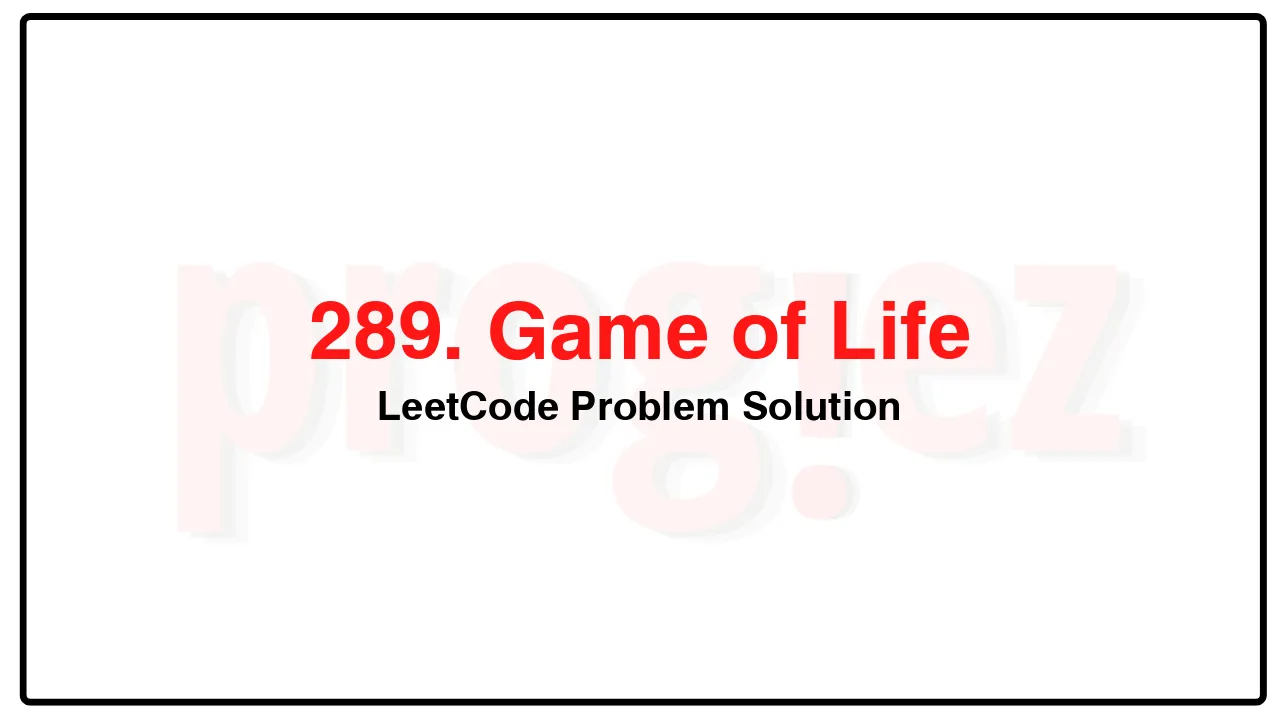289. Game of Life LeetCode Solution
In this guide, you will get 289. Game of Life LeetCode Solution with the best time and space complexity. The solution to Game of Life problem is provided in various programming languages like C++, Java, and Python. This will be helpful for you if you are preparing for placements, hackathons, interviews, or practice purposes. The solutions provided here are very easy to follow and include detailed explanations.
Table of Contents
- Problem Statement
- Complexity Analysis
- Game of Life solution in C++
- Game of Life solution in Java
- Game of Life solution in Python
- Additional Resources

Problem Statement of Game of Life
According to Wikipedia’s article: “The Game of Life, also known simply as Life, is a cellular automaton devised by the British mathematician John Horton Conway in 1970.”
The board is made up of an m x n grid of cells, where each cell has an initial state: live (represented by a 1) or dead (represented by a 0). Each cell interacts with its eight neighbors (horizontal, vertical, diagonal) using the following four rules (taken from the above Wikipedia article):
Any live cell with fewer than two live neighbors dies as if caused by under-population.
Any live cell with two or three live neighbors lives on to the next generation.
Any live cell with more than three live neighbors dies, as if by over-population.
Any dead cell with exactly three live neighbors becomes a live cell, as if by reproduction.
The next state of the board is determined by applying the above rules simultaneously to every cell in the current state of the m x n grid board. In this process, births and deaths occur simultaneously.
Given the current state of the board, update the board to reflect its next state.
Note that you do not need to return anything.
Example 1:
Input: board = [[0,1,0],[0,0,1],[1,1,1],[0,0,0]]
Output: [[0,0,0],[1,0,1],[0,1,1],[0,1,0]]
Example 2:
Input: board = [[1,1],[1,0]]
Output: [[1,1],[1,1]]
Constraints:
m == board.length
n == board[i].length
1 <= m, n <= 25
board[i][j] is 0 or 1.
Follow up:
Could you solve it in-place? Remember that the board needs to be updated simultaneously: You cannot update some cells first and then use their updated values to update other cells.
In this question, we represent the board using a 2D array. In principle, the board is infinite, which would cause problems when the active area encroaches upon the border of the array (i.e., live cells reach the border). How would you address these problems?
Complexity Analysis
- Time Complexity: O(mn)
- Space Complexity: O(1)
289. Game of Life LeetCode Solution in C++
class Solution {
public:
void gameOfLife(vector<vector<int>>& board) {
const int m = board.size();
const int n = board[0].size();
for (int i = 0; i < m; ++i)
for (int j = 0; j < n; ++j) {
int ones = 0;
for (int x = max(0, i - 1); x < min(m, i + 2); ++x)
for (int y = max(0, j - 1); y < min(n, j + 2); ++y)
ones += board[x][y] & 1;
// Any live cell with two or three live neighbors lives on to the next
// generation.
if (board[i][j] == 1 && (ones == 3 || ones == 4))
board[i][j] |= 0b10;
// Any dead cell with exactly three live neighbors becomes a live cell,
// as if by reproduction.
if (board[i][j] == 0 && ones == 3)
board[i][j] |= 0b10;
}
for (int i = 0; i < m; ++i)
for (int j = 0; j < n; ++j)
board[i][j] >>= 1;
}
};
/* code provided by PROGIEZ */289. Game of Life LeetCode Solution in Java
class Solution {
public void gameOfLife(int[][] board) {
final int m = board.length;
final int n = board[0].length;
for (int i = 0; i < m; ++i)
for (int j = 0; j < n; ++j) {
int ones = 0;
for (int x = Math.max(0, i - 1); x < Math.min(m, i + 2); ++x)
for (int y = Math.max(0, j - 1); y < Math.min(n, j + 2); ++y)
ones += board[x][y] & 1;
// Any live cell with two or three live neighbors lives on to the next
// generation.
if (board[i][j] == 1 && (ones == 3 || ones == 4))
board[i][j] |= 0b10;
// Any dead cell with exactly three live neighbors becomes a live cell,
// as if by reproduction.
if (board[i][j] == 0 && ones == 3)
board[i][j] |= 0b10;
}
for (int i = 0; i < m; ++i)
for (int j = 0; j < n; ++j)
board[i][j] >>= 1;
}
}
// code provided by PROGIEZ289. Game of Life LeetCode Solution in Python
class Solution:
def gameOfLife(self, board: list[list[int]]) -> None:
m = len(board)
n = len(board[0])
for i in range(m):
for j in range(n):
ones = 0
for x in range(max(0, i - 1), min(m, i + 2)):
for y in range(max(0, j - 1), min(n, j + 2)):
ones += board[x][y] & 1
# Any live cell with two or three live neighbors lives on to the next
# generation.
if board[i][j] == 1 and (ones == 3 or ones == 4):
board[i][j] |= 0b10
# Any dead cell with exactly three live neighbors becomes a live cell,
# as if by reproduction.
if board[i][j] == 0 and ones == 3:
board[i][j] |= 0b10
for i in range(m):
for j in range(n):
board[i][j] >>= 1
# code by PROGIEZAdditional Resources
- Explore all LeetCode problem solutions at Progiez here
- Explore all problems on LeetCode website here
Happy Coding! Keep following PROGIEZ for more updates and solutions.









